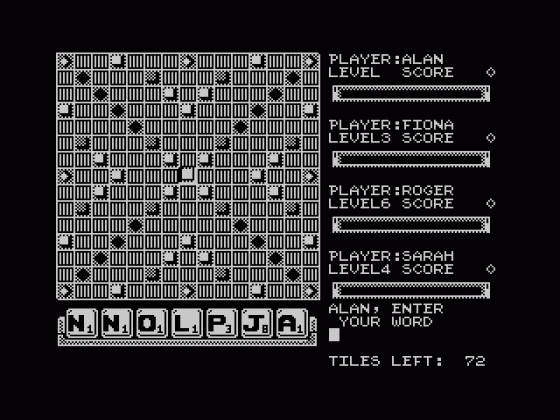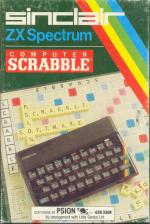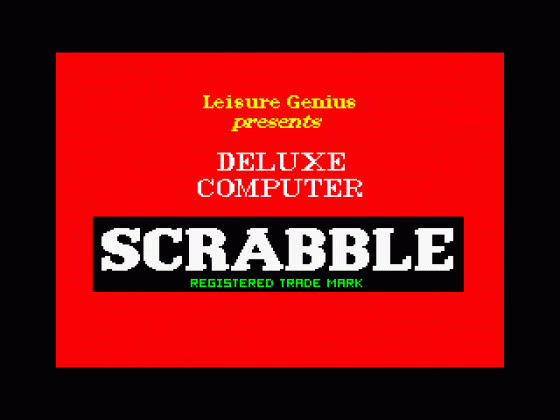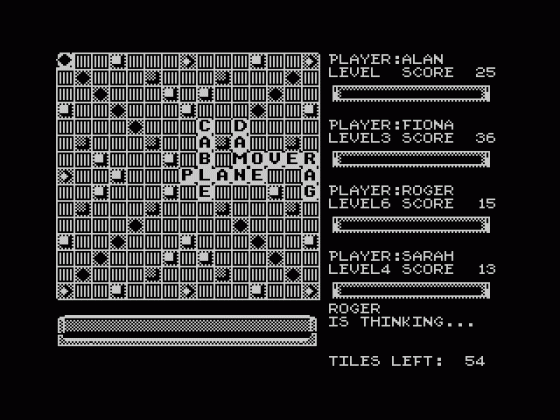
ZX Computing
 1st December 1983
1st December 1983
Categories: Review: Software
Author: David Rowley
Publisher: Sinclair Research
Machine: Spectrum 48K
Published in ZX Computing #10
Computer Scrabble
About ten years ago I seriously considered writing a program to play Scrabble on PDP-8. However, I soon realised that the program's vocabulary would be so small that it would probably end up passing on half its turns. Now, Psion have produced a program with a vocabulary of over eleven thousand words (yes 11,000) for the Spectrum 48K. But having a large vocabulary is only part of what is needed to succeed at Scrabble, you need to see where the letters can be placed and decide on your strategy - is it really a good idea to open up the triple word square for your opponent?
So, on to a description of the 'product', as the marketing managers call it. The cassette comes in a miniature version of the box the original game comes in, so it is instantly recognisable. Inside the box is a professionally produced booklet describing the game for those who are unfamiliar with it, and details of how to operate the program. Although the program contains quite a lot of instructions, these are all straight-forward and easy to understand. The first trick, of course, is to load the program and after a couple of failures on side A, side B loaded first time, as it has done ever since.
On successful loading of the program a number of questions appear:

1. Is your television colour or black and white; press C for colour or B for black and white. 2. Do you wish to reload a previously saved game; type Y for yes or N for no. 3. Number of players: press 1 to 4. 4. Name of player: type name (max. 8 letters) then ENTER. 5. Whether this player is the computer or not: type Y for yes or N for no. 6. If yes then at what level do you wish the computer to play for this player; press 1 to 4, where 4 is the hardest level. 7. Do you wish to see the computer's letter rack: press Y or N. 8. Do you want to see the computer trying its moves: press Y or N.
The first option I wanted was to see the computer playing against itself, so I opted for level three against level four, with the options of seeing the computer's letter rack, and seeing it try its moves. Immediately on the screen was the Scrabble board, with different colours representing different square values. For the player currently taking a turn, the rack of letters is displayed, although not after they are placed on the board. On the right of the screen are the current totals of all players, the letter racks of all players, the number of tiles remaining, and a list of options. This game was marred a little because the letters which came up on the racks were very difficult to score well with, e.g. six vowels, or a 'Q' and an 'X' at the same time. However, level 4 ended up the winner, by 284 to 254. What was fascinating was to see the computer trying its moves. The flashing cursor square darted all over the board, trying out potential words, and printing things like "extra would score 32". Still, the real test of the program was to come.
As a finalist at the British Scrabble Championships some years ago, I felt quite confident. I set the program level 4, and asked the computer to keep its tiles hidden and not to visibly try out it moves. After scoring 32 on my first go I felt confident. But that confidence immediately disappeared, for the computer placed a full word and got on a triple word square to score a total of 86. The rest of the game was superb. The tiles came up well, and some good words were placed. The final scores were 358 to the computer and 332 to me. Although I caught up towards the end of the game, to be honest I never looked like winning.

So, a victory first time out for the computer. I have beaten level fur since, but it is not easy. I mentioned earlier that there are a number of options available. When it is a particular player's turn these options may be chosen:
Symbol shift V displays the letter tiles of all players Symbol shift S displays the values of various special value squares Symbol shift R allows you to rearrange your tiles in any way you wish Symbol shift C allows you to change any number of tiles you wish Symbol shift J tells the computer to re-arrange the tiles in a random fashion Symbol shift Q abandons the game and gives you the option of saving the game or starting a new one
It is also possible to pass if you cannot place any letters.

All the options available in the original game are available here - even knocking the board over can be accomplished by 'accidentally' pulling out the power lead. Placing a word on the board is much easier than I thought it would be. You simply move the cursor to where you want the word, type A if the word is to go across the board or D if it is to go down, and then type the word. The computer then places the word on the board, gives you your score, and the option of changing your mind if you wish to play somewhere else instead. When you finally enter the word, the computer checks to see if the words formed are present in its vocabulary. If there are the game progresses; if they are not, the computer asks you if you are sure about the word. If you answer yes, the computer accepts it.
I mentioned the importance of strategy in Scrabble and here it is worth noting that the different levels appear to have different strategies. Level one seems to make little effort to score its maximum possible each turn, apparently placing tiles as soon as it finds somewhere they will go, and it has a very fast response time. By contrast, level four always seems to attempt to get the maximum score possible, with one or two exceptions, e.g. if it has a blank it will not place it unless it gets quite a good score with it, but keeps it for a later turn. Dr. Peter Turcan, who Psion acknowledge as having played a large part in the development of the program, and Psion themselves, are to be congratulated on this program. For the beginner, levels one and two introduce you to the game, while level three provides a pleasant respite from the excellent lay of level four for the more experienced player. The program also appears to play an open rather than a defensive game, which is much more fun for its opponent.
Are there are criticisms of the program? Only two, the fist of which I am pretty sure can be solved only by using other hardware, like a pen and paper, or a Scrabble set. This problem arises if you wish to play against the computer and against human players at the same time. While the computer can keep its letters hidden, the other human opponent cannot.

Still, more Scrabble enthusiasts believe that two person games are much more fun anyway.
The second criticism is the price, £15.95. Maybe it reflects the box the program comes in, maybe not, but Psion are likely to lose sales to those potential customers who have only played Scrabble a few times and thus, not prepared to pay this much.
Overall, a superb program, particularly if you are a Scrabble enthusiast, without a regular opponent. But how about a price cut?
Other Reviews Of Computer Scrabble For The Spectrum 48K
Computer Scrabble
Numb's The Word
Scrabble (Psion)
A review by R.E. (Home Computing Weekly)
Computer Scrabble (Leisure Genius)
A review by (Sinclair User)
Scrabble (Psion)
A review
The Spectrum Collection
Tony Hetherington selects fifteen classic games that all Spectrum owners should have







